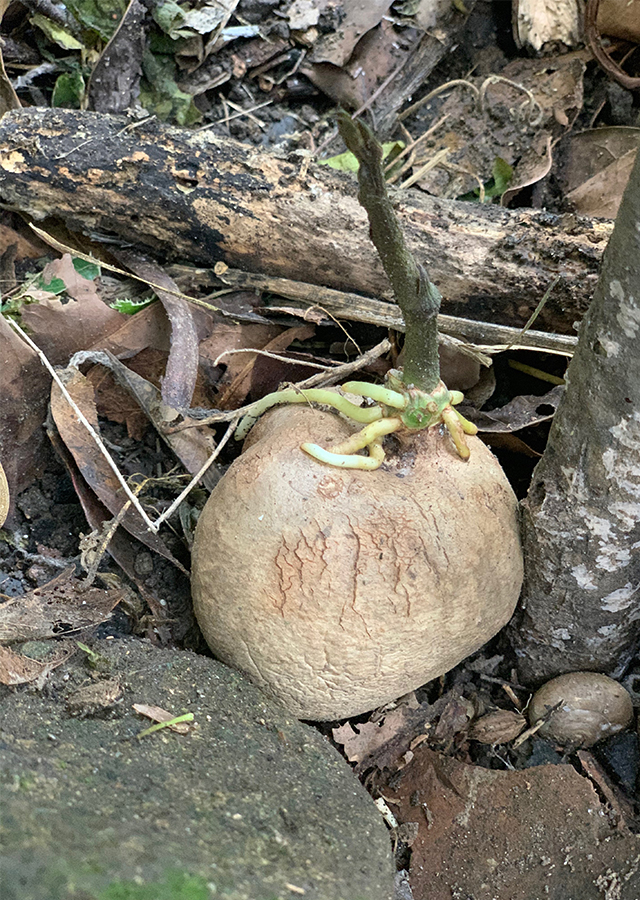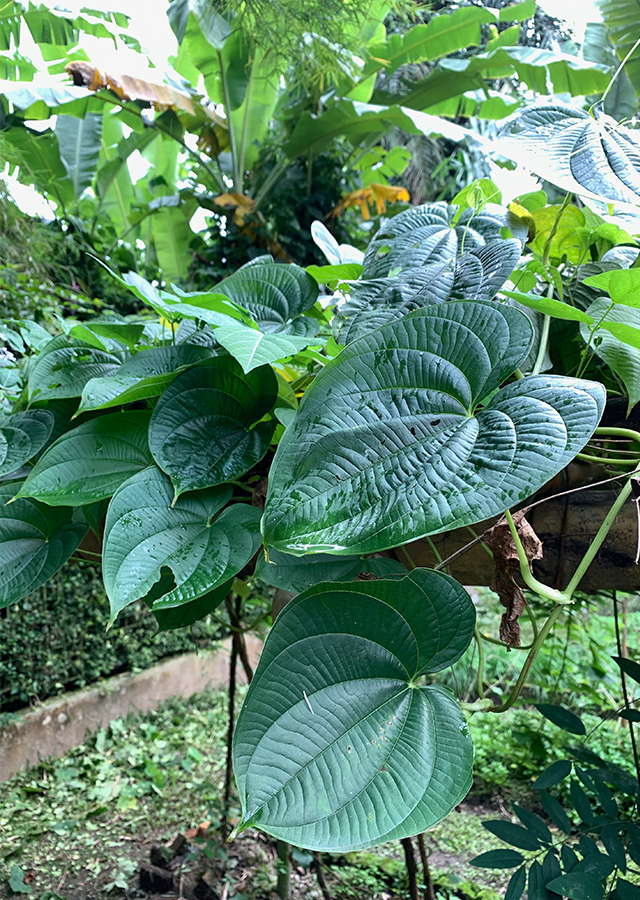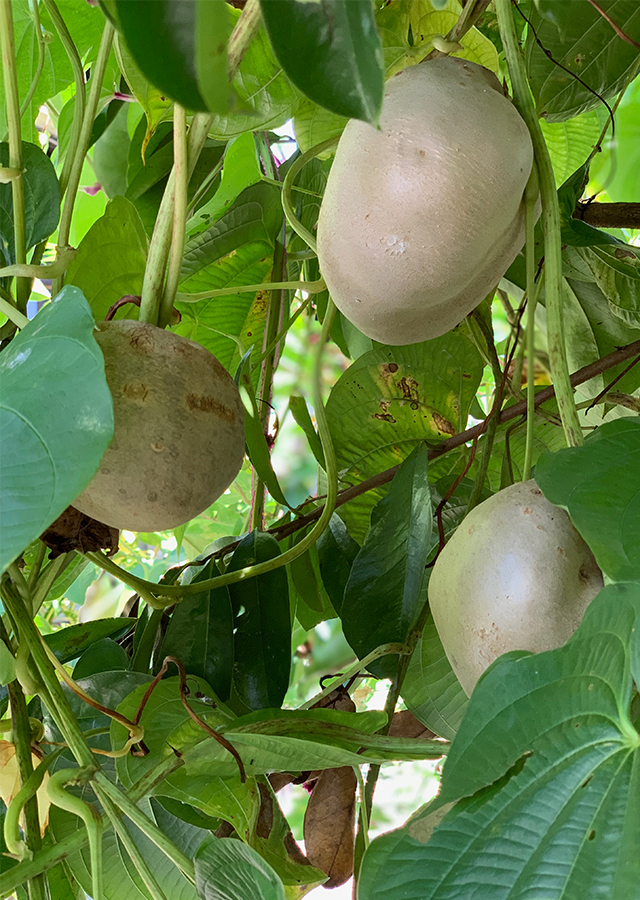Air Potato
Dioscorea bulbifera L.
Dioscoreaceae
Location in our garden
Principal



Synonym
Dioscorea anthropophagorum A. Chev.
Dioscorea crispata Roxb.
Dioscorea heterophylla Roxb.
Habitus
Herbaceous. A monocotyledonous, dioecious, perennial vine. Its annual stem up to 10 m long, which arise from a tuber, twine counterclockwise
Part Used
Leaves
Roots
Tuber
Growing Requirements
Full Sunshine
Need Shade
High Rainfall
Habitat
Riverbanks
Forest
Shrublands
Grassland
Overview
Some authors believe that both Asia and tropical Africa are native to this species. Still, others believe that it is a native of Asia and has subsequently been introduced into Africa. It is currently widely naturalized and cultivated in America, the West Indies, and the Pacific Islands in tropical and subtropical areas.
Vernacular Names
Bitter yam (English), Name blanco (Spanish), Igname bulbifere (French), Huang du (Chinese), Brotwurzel (German), Khoai dái (Vietnamese), Hoei-oepas (India).
Agroecology
A plant from the lowlands humid tropics. It grows best in areas with annual daytime temperatures are within the 20-30 °C range, but can withstand 12-38 °C. Average annual precipitation in the range of 1,200-2,600 mm is preferred, but 900-4,000 mm is tolerated. It needs a thick, well-drained, sandy loam for best yields that is not responsible for water-logging. A pH in the 6-6.7 range is favored, tolerating 5.3-8.
Morphology
- Tubers - are rounded, not larger than a man's fist.
- Stem - non-spiny stems to 20 m or more in length, freely branching above, internodes round or slightly angled in cross-section.
- Leaves - alternate, blades 9-12.5 × 5.5-11 cm, ovate, chartaceous, glabrous, the apex acuminate to caudate, base cordate, margins slightly undulate, petioles 12-15 cm long.
- Flowers - white or pinkish-tinged, diminutive, and sessile, staminate flowers with perianth approximately 1.2 mm long and 6 fertile stamens, inflorescences are axillary and simple fasciculate.
- Fruits - capsules 3-winged, 2.5 cm long.
- Bulbils (aerial tubers) - may be brown with a warty texture or light tan to gray with a smooth skin; generally globose.
Cultivation
- New plants develop from bulbils that form on the stem of the plant, and these bulbils fall to the ground and serve as the primary means of dispersal.
Chemical Constituents
The plant contains flavonoids, alkaloida andpolifenol. saponin steroids, cardiac glycosides, terpenoids, dioscorine, diosgenin, palmitic acid.
Traditional Medicinal Uses
- In Chinese traditional medicine, is effective against several therapeutic diseases such as cancer, goiter, skin infections, pharyngitis, hemoptysis, and orchitis, also kidney and liver damage.
- Air potatoes have anti-inflammatory, anti-oxidant activity in nature. Anti-microbial, analgesic, and gastroprotective roles are other areas protected.
- The tonic, expectorant, aphrodisiac, and anthelmintic tubers were considered.
- Anti-cancer, wound healing, antihyperglycemic, antidyslipidemic and cardioprotective effects have been indicated by research.
- Air potatoes are used to help against diarrhea, sore throats, and jaundice in traditional Ayurvedic medicine.
- To expel threadworm, the juice of the roots is taken.
- For the treatment of wounds, sores, boils, and inflammations, both the tuber and the bulbil as a poultice; in dressings for the treatment of dermal parasitic and fungal infections; or crushed, combined with palm oil and massaged into areas of rheumatism and breast and jigger disorders.
- The tuber is known as a diuretic in India and as a treatment for diarrhea, piles, ulcers, diabetics, and hemorrhoids.
- The fruits are used for the prevention of fever and boils.
- For treating purulent ophthalmia, and for snake-bite, sap expressed from the vine stems is added.
- The leaves are used for skin diseases, often by steam-distillation, against pink-eye.
Part Used
Reference Sources
- CABI. (No date). Invasive Species Compendium. Dioscorea bulbifera (air potato). https://www.cabi.org/isc/datasheet/19295#tosummaryOfInvasiveness. 17-12-2020.
- Florida Department of Agriculture and Consumer Services. (No date). Dioscorea bulbifera, Air Potato. https://www.fdacs.gov/Divisions-Offices/Plant-Industry/Bureaus-and-Services/Entomology-Nematology-Plant-Pathology/Botany/Noxious-Weeds/Dioscorea-bulbifera-Air-Potato. 14-12-2020.
- Everglades CISMA. (No date). Air Potato. https://www.evergladescisma.org/the-dirty-dozen/air-potato/. 17-07-2020.
- Fern, Ken. (2019). Useful Tropical Plants Database. Dioscorea bulbifera. http://tropical.theferns.info/viewtropical.php?id=Dioscorea+bulbifera. 14-12-2020.
- Kundu, B.B., Vanni, K., Farheen, A., Jha, P., Pandey, D.K., & Kumar, V. (2020). Dioscorea bulbifera L. (Dioscoreaceae): A review of its ethnobotany, pharmacology and conservation needs. South African Journal of Botany 000:1-10. http://doi.org/10.1016/j.sajb.2020.07028


